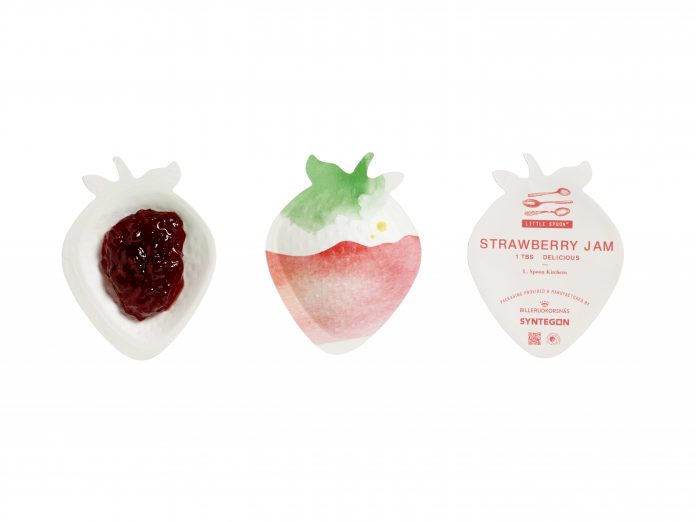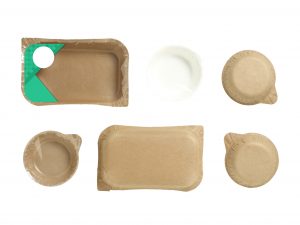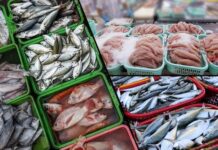
As part of an EIT-funded project, Syntegon has developed paper-based trays and cups for sensitive food products. Together with partners from industry and research, namely Fraunhofer Institute for Process Engineering and Packaging in Dresden, Colruyt Group, Strauss Group, and the University of Reading, Syntegon is implementing the EIT project “Pack4Sense” (Paper packaging for SENSitive foods) to develop a sustainable packaging concept. EIT Food, said to be the world’s largest and most dynamic innovation community, is supported by the European Institute of Innovation and Technology (EIT), a body of the European Union.
Optimal recyclability thanks to paper & mono-material
The aim of the project is to pack even sensitive products with high barrier properties in more sustainable materials. Syntegon uses a special paper, which is particularly stretchable and tearproof thanks to long cellulose fibers, thus enabling the production of sealed trays and cups with a depth of up to 30 millimeters.
A recycable barrier layer made of 95 percent mono-materials provides optimal product protection. The paper and the barrier layer, as well as the cover film can be easily separated, ensuring full utilization of its recyclability.

depth of up to 30 millimeters are
fully recyclable: The paper and the
barrier layer, made from 95
percent mono-material, as well as
the cover film can be easily
separated for easy disposal in
different waste streams. Photo Syntegon
This sustainability advantage, however, also poses challenges for packaging manufacturers. On the one hand, consumers should be able to separate all components for waste sorting. On the other hand, paper and film must not be detached from each other unintentionally. To prevent this from happening, the TPU paper forming, filling, and sealing machine from Syntegon forms paper and barrier layer in a common process by thermoforming and pressing. “With the paper-based trays from the “Pack4Sense” project, we have further developed our previous paper packaging solutions like the shaped paper pods – structured paper trays for the packaging of cosmetics and confectionery,” explains Matthias Klauser, project manager, and sustainability expert at Syntegon.
TPU brings paper and barrier layer together
The TPU has already been honored with the German Packaging Award in 2020 and is Syntegon’s flagship machine for paper forming. For the Pack4Sense trays and cups, the paper runs directly from the roll into the feeder – the barrier layer required for sealing is applied and joined to the paper without any further conversion step. Alternatively, manufacturers can use a converter to connect paper and a protective layer of mono-material without heating. A forming station presses the materials into shape before the trays are filled and sealed. In addition to using a particularly stretchable paper that can withstand wrinkling during the forming process, it is important to preserve the separability of the materials – a specially adapted geometry of the forming tools reduces the tension on the materials during the manufacturing process.
Syntegon is continously working on further developing its paper-forming technology. EIT Food enables the company to work closely with important partners and to test products together with consumers and food manufacturers. This cooperation makes it possible to develop prototypes and solutions that meet product requirements and optimize the sustainability of packaging step by step.
IndiFoodBev — authentic, impactful and influential
An English-language food and beverage processing and packaging industry B2B platform in print and web, IndiFoodBev is in its third year of publication. It is said that the Indian food and beverage industries represent approximately US$ 900 billion in revenues which implies more than 20% of the country’s GDP. Eliminating the wastage on the farmside can help to deliver more protein to a higher number of the population apart from generating sizable exports. The savings in soil, seeds, water, fertilizer, energy and ultimately food and nutrition could be the most immense contribution that country is poised to make to the moderation of climate change.
To improve your marketing and grow sales to the food and beverage processing and packaging industry, talk to us. Our research and consulting company IppStar [www.ippstar.org] can assess your potential and addressable markets in light of the competition. We can discuss marketing, communication, and sales strategies for market entry and growth.
Suppliers and service providers with a strategy and budget for targeted marketing can discuss using our hybrid print, web, video, and social media channels to create brand recognition linked to market relevance. Our technical writers are ready to meet you and your customers for content.
The second largest producer of fruit and vegetables in the world is continuously expanding processing capacities and delivery systems with appropriate innovative technologies. We cover product and consumer trends, nutrition, processing, research, equipment and packaging from farm to thali. Get our 2025 media kit and recalibrate your role in this dynamic market. Enhance your visibility and relevance to existing markets and turn potential customers into conversations. Ask for a sample copy of our bi-monthly in print or our weekly IndiFoodBev eZine each Wednesday.
For editorial info@ippgroup.in — for advertisement ads1@ippgroup.in and for subscriptions subscription@ippgroup.in
Naresh Khanna – 10 February 2025
Subscribe Now










